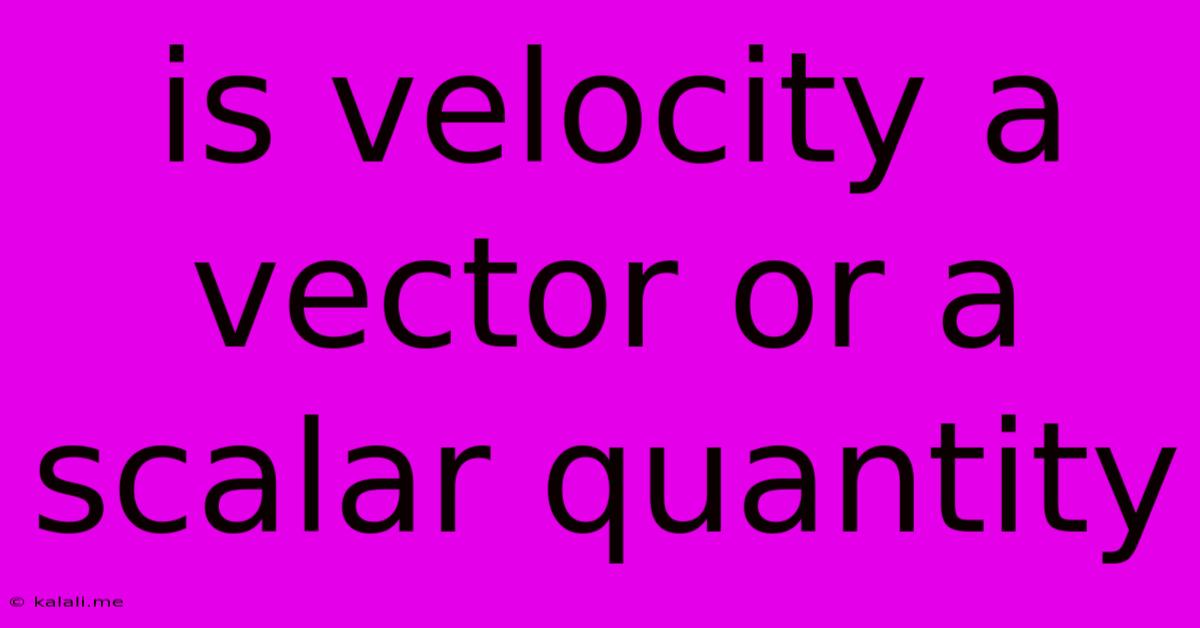Is Velocity A Vector Or A Scalar Quantity
Kalali
May 19, 2025 · 3 min read

Table of Contents
Is Velocity a Vector or a Scalar Quantity? Understanding the Difference
Understanding whether velocity is a vector or a scalar quantity is fundamental to grasping basic physics. This article will clearly explain the difference between scalar and vector quantities, and definitively answer the question: velocity is a vector quantity. We'll explore why, providing examples to solidify your understanding. This will help you not only ace your physics exam but also understand the world around you better.
What are Scalar and Vector Quantities?
Before we delve into the specifics of velocity, let's define our key terms:
-
Scalar Quantity: A scalar quantity is a quantity that is fully described by its magnitude (size or amount). It only has one component: its numerical value. Examples include: speed, mass, temperature, and time. Think of it as a single number.
-
Vector Quantity: A vector quantity is a quantity that has both magnitude and direction. It needs both to be completely defined. Think of it as an arrow: the length of the arrow represents the magnitude, and the direction the arrow points represents the direction. Examples include: displacement, force, acceleration, and, as we'll see, velocity.
Why Velocity is a Vector
Velocity describes how quickly an object's position is changing and in what direction. This dual requirement—magnitude and direction—makes it a vector quantity.
Let's contrast it with speed:
-
Speed: Speed is a scalar quantity. It only tells us how fast an object is moving (e.g., 60 mph). It doesn't provide information about the direction of motion.
-
Velocity: Velocity tells us both how fast an object is moving and in what direction (e.g., 60 mph due north). The direction is crucial; a change in direction constitutes a change in velocity, even if the speed remains constant.
Illustrative Examples
Consider these scenarios:
-
Scenario 1: A car is traveling at 50 km/h. This is its speed (scalar). If we add the direction, for example, "50 km/h east," we now have its velocity (vector).
-
Scenario 2: Two cars are moving at the same speed (scalar), but in opposite directions. They have different velocities (vector) because the directions of their motion are different.
-
Scenario 3: A ball is thrown upwards. Its speed decreases as it goes up, then increases as it falls back down. However, its velocity is constantly changing because both the speed and direction (upwards then downwards) are changing.
Understanding the Implications
The vector nature of velocity has significant implications in various physics calculations. For instance, when calculating the net effect of multiple forces acting on an object (like in projectile motion), you must account for both their magnitudes and directions – a direct consequence of dealing with vector quantities. This is where vector addition comes into play.
In Conclusion
Velocity is unequivocally a vector quantity. It's a crucial distinction to make when studying physics, as it affects how we represent and calculate motion. Remember, while speed tells us "how fast," velocity tells us "how fast" and "in which direction." This understanding forms a solid foundation for more advanced physics concepts.
Latest Posts
Latest Posts
-
Can You Use Water As Engine Coolant
May 19, 2025
-
Countries With No Extradition Treaty With Uk
May 19, 2025
-
How Long Does Wood Glue Take To Dry
May 19, 2025
-
Does Car Battery Charge While Idle
May 19, 2025
-
Permission Denied Publickey Gssapi Keyex Gssapi With Mic
May 19, 2025
Related Post
Thank you for visiting our website which covers about Is Velocity A Vector Or A Scalar Quantity . We hope the information provided has been useful to you. Feel free to contact us if you have any questions or need further assistance. See you next time and don't miss to bookmark.